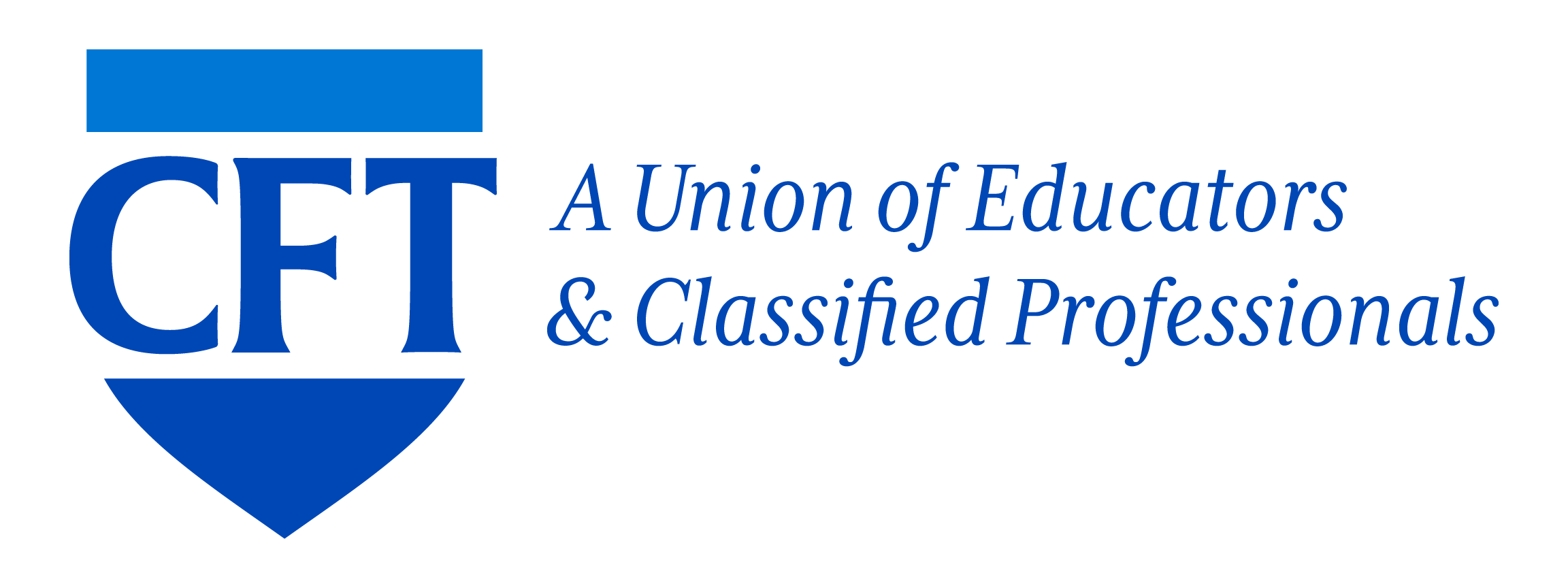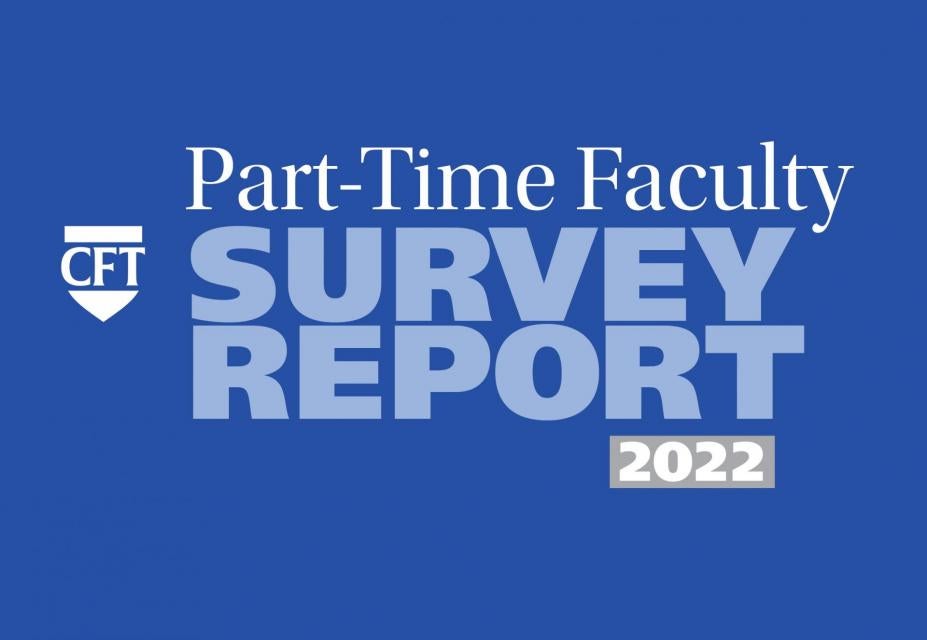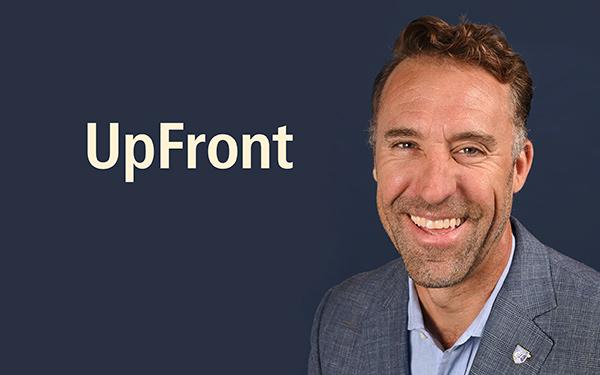The results of CFT’s groundbreaking statewide survey of part-time faculty offer critical insights into the daily, personal, and structural challenges that part-time and contingent faculty experience when it comes to healthcare.
The data were collected between February 22 and April 22, 2022 from a survey of contingent and adjunct faculty employed in California. The survey was circulated among CFT/AFT local unions that represent part-time and contingent faculty, however the survey was open to any faculty member who was employed in a part-time, contingent, or adjunct position at a California college or university during the 2021-22 academic year. More than 2,500 part-time faculty responded. The vast majority of respondents are community college faculty representing 58 of the state’s 72 community college districts.
Accounting for more than two-thirds of the faculty employed by the California community colleges, contingent faculty are the largest group of employees in the system, and essential to the education of the 1.8 million students who attend classes at one of the state’s 115 community colleges. Only a fraction of them receive health insurance benefits.
Download our report and data summary
CFT Part-Time Faculty Survey Report (footnoted version)
CFT Part-Time Faculty Survey Report — Data Toplines
CFT’s survey findings shine a light on the daily struggles that part-time faculty experience when it comes to healthcare. The scarcity of employer healthcare benefits for faculty adds another layer of precarity to the already insecure, though essential, jobs that part-time faculty perform.
Governor Newsom’s January budget proposal for 2022-23 includes $200 million to improve access to healthcare benefits for part-time faculty in the community colleges. If the legislature supports the proposal, the survey results show this expansion in healthcare coverage could be life changing.
Inequitable jobs, perpetual insecurity
Only one in four college faculty in the United States are employed in permanent, full-time positions. The vast majority are contingent, adjunct, and primarily part-time positions. The AFT’s 2022 report, “An Army of Temps,” describes the working conditions for this group succinctly:
“The decades-long crisis of contingent workers in our colleges and universities is in many ways the original “gig economy,” with all its attendant woes: low wages, few benefits, little job security, and the expenses of work being shifted from the employer to the at-will employee.”
In California’s Community College system, most educators are part-time faculty; over the past five years, nearly 7 in 10 of the roughly 60,000 faculty have been part-time, with some districts employing more than 80% of their faculty on part-time basis.
Despite having the same or similar qualifications and education, part-time faculty are paid hourly, at rates much lower than their full-time colleagues, and perform many parts of their jobs without any compensation. Their employment is unacceptably and unnecessarily uncertain; class schedules sometimes unconfirmed until the very last minute and assignments (hours) cut for reasons beyond the instructor’s control, part-time faculty are vulnerable and cannot plan or count on having regular work.
| Who Are Part-Time Faculty? |
|---|
| Part-time faculty have the same credentials and qualifications as their full-time faculty peers. |
|
| For most, this is their profession. Part-time faculty have many years of experience; being a college teacher is not a side hustle or extra gig. |
|
With inequitable and low pay and job insecurity for contingent faculty so rampant throughout academia, it is a fairly open secret. These issues are being highlighted regularly in both national and statewide media reports and were central in the UC-AFT’s successful contract campaign last year, which exposed these inequities embedded in California’s esteemed University of California system.
Few part-time faculty receive employer healthcare benefits
A perhaps more guarded secret, is the experience of insecure, insufficient, and precarious healthcare for contingent faculty.
Despite the heavy and growing reliance on part-time faculty, California’s state budget allocates less than a half-million dollars each year to support health insurance for this essential employee group. Funded at $490,000 per year, the community college program that provides resources for districts that offer part-time faculty healthcare benefits pencils out to about $13 per part-time faculty member this year.
|
TABLE 1. Participation in Part-Time Health Insurance Program |
|||
|
Year |
Districts reporting participants |
Part-Time Faculty participants |
Part-Time Faculty employed |
|
2018-19 |
37 |
4,673 |
42,800 |
|
2018-19 |
35 |
3,931 |
42,247 |
|
2020-21 |
33 |
3,519 |
37,396 |
|
Source: CA Community College Chancellor’s Office, CCCCO Datamart, Faculty and Staff Demographic Reports for PT faculty employed, fall term. |
|||
According to records provided by the Chancellor’s Office, only about half of the districts report offering qualifying healthcare benefits and only a small fraction of faculty employed are enrolled or participating. The program allows for districts to receive up to 50 percent of the employer’s costs for health insurance offered to part-time faculty, however it is so woefully under-funded, districts receive only a few cents per eligible dollar. A handful of districts offer some healthcare benefits to part-time faculty but do not report costs and enrollment to the Chancellor’s Office.
Most of the CFT survey respondents do not receive healthcare benefits from their higher education employer: only one in three said their insurance was provided through their higher education employer. Another 36 percent receive health benefits through a spouse or a different employer, and 6 percent said they have no insurance. Extrapolating to the population of part-time faculty, this would mean more than 2,200 faculty were living through the pandemic without any health insurance.
The majority of respondents were earning $40,000 or less this year from their part-time faculty faculty positions. Few get health insurance from a higher education employer.
The healthcare benefits available to part-time faculty is wildly variable. Eligibility thresholds vary from district to district as do the benefits. Only a fraction of the part-time faculty ever qualifies for health benefits, and many of the benefits options are vastly inadequate or so costly that they are unrealistic and inaccessible.
On top of the often high thresholds for eligibility, many part-time faculty work at multiple colleges and universities — in some cases, a person may even teach in multiple systems (e.g,. a community college and a CSU campus). Faculty cannot combine their community college appointments in order to qualify (though CSU appointments at different campuses can be combined to qualify for CSU benefits). Part-time faculty who do qualify are always at risk of losing their coverage should a course get cancelled for any reason.
|
TABLE 2. Percent of respondents who rationed their own healthcare due to a lack of or insufficient coverage |
|||
|
63% |
Put off/postponed getting dental care/checkups |
||
|
44% |
Put off/postponed getting healthcare (incl. mental health services) that you needed |
||
|
43% |
Did not go to see a doctor |
||
|
30% |
Did not get a medical test/treatment that was recommended by a doctor |
||
|
21% |
Chose a less expensive treatment than the one your doctor recommended |
||
|
19% |
Did not fill a prescription for medicine (for self or dependent) |
||
|
12% |
Skipped/postponed rehabilitation care that your doctor recommended |
||
|
11% |
Cut pills in half/skipped doses of medicine |
||
This outcome, however, is a choice, and is not inevitable. Full-time, tenured and tenure track faculty across all segments of California’s higher education system receive excellent healthcare benefits. At a handful of community college districts, part-time faculty can qualify to receive the same employer-paid benefits as their full-time peers if they teach half-time or more.
In the California State University system, contingent faculty who teach at least 40 percent are eligible to receive the same, employer-paid health benefits as their full-time, tenure track peers. These are models and examples of what is possible, and could be expanded throughout the community college system with the proposed support of $200 million.
|
TABLE 3: Where faculty report getting their health insurance from |
|
|
33% |
Higher education employer |
|
22% |
Spouse’s or domestic partner’s employer |
|
14% |
Another employer |
|
12% |
Covered California |
|
12% |
Purchase individual or family coverage, separate from any employer |
|
6% |
No health insurance |
|
5% |
Medi-Cal |
Survey provides critical insights
This statewide survey offers important details about how the poor access to health insurance benefits affects faculty, and the challenges they contend with while they perform their jobs. These new data add to the findings from an investigation and report on conditions in California published earlier this year by EdSource and to national studies by AFT and others.
CFT’s analysis found a wide range of healthcare benefits are available to part-time faculty. While about half of the districts offer no benefits to part-time faculty, many districts offer options for part-time faculty to enroll in plans that are poor quality, with high deductibles or excessively high employee contribution rates that are untenable given the low pay.
Some districts offer modest reimbursements to offset the costs that faculty pay for plans they purchase on their own, but these are much lower than the actual cost of a high-quality plan (e.g., $180 per month or $75 per semester, when the plan for a single person could easily exceed $1,000 per month). In addition, each district has its own eligibility requirements that often require a minimum appointment (e.g., 50% of full-time) for several semesters before any benefits kick in.
| Debunking Myths About Part-Time Faculty Healthcare |
|---|
| MYTH: Part-time faculty don’t need benefits, because they have other jobs and college teaching is just a side hustle, providing extra income. FACT: Only 14% of the survey respondents get health benefits from another employer. For 78%, their work as a faculty member is their primary employment, but only a third get their health insurance through their college or university employer. |
| MYTH: Part-time faculty don’t stay long in their jobs, they are a temporary step on in a long career. FACT: Most part-time faculty have an average of 13 years of experience (35% have more than 15 years of experience and only 23% have less than five years. Three-quarters would take more work if offered, and fewer than half are actively seeking full-time, tenure-track positions. |
The Chancellor’s Office data shows some districts have plans that only a handful of faculty participate in — but it is unclear whether it is because the plan is too expensive, too hard to qualify for, or the plan does not offer what the employee needs. For instance, last year, six of the districts that submitted data for reimbursement reported providing benefits to 10 or fewer faculty. Overall, these reports show only 9 percent of the part-time faculty receiving any health benefits. However, in districts where part-time faculty who qualify receive benefits equivalent to those offered to full-time faculty, the participation rate is in the 30 to 40 percent range.
CFT’s survey invited faculty to document their experiences to shed more light on the scale and scope of their healthcare challenges.
The survey was made available through purposive sampling through direct communications to members, social media, and the CFT website. The results are consistent with other research about contingent faculty and are supported by qualitative data collected from part-time faculty. The insights are timely and underscore the urgency of healthcare.
The results provide important insights into part-time faculty experiences, challenging pervasive popular myths that enable the inequitable and insecure working conditions to persist. They show how the tens of thousands of part-time faculty, on whom these colleges and students critically depend, are effectively subsidizing the nation’s largest public college system with their very own health.
Time to act!
More than two years into a global pandemic that has taken millions of lives – including 89,000 Californians — the urgency of healthcare has never been so clear. COVID-19 makes inequities in our society more visible than ever, and impossible to ignore.
Many part-time faculty reported struggling to make ends meet, illustrating what poor access to healthcare means in practical terms. it means putting off needed care for themselves or families, and skipping tests that could provide critical diagnoses.
At the same time, California’s state budget has never been larger, with surplus projections in the billions. State funding for community colleges, through Proposition 98, has also never been so high. Against this backdrop, Governor Newsom’s January budget proposed adding $200 million to expand access to healthcare for part-time faculty in the community colleges. With this confluence of circumstances, the time to act is now.
The California Community College system is the bedrock of the state’s world renown public higher education system, which was boldly envisioned more than 60 years ago in California’s Master Plan for Higher Education. The colleges educate more 1.8 million students each year, including 29 percent of the graduates from the University of California and half of all California State University graduates. The system’s homepage celebrates its contribution to upward mobility, noting “California’s community colleges are at the forefront in combating income inequality and are trailblazers in supporting social and economic mobility.” It is unacceptable that the nation’s largest public institution of higher education fails to provide accessible healthcare to the majority of its faculty.
Part-time faculty comprise about 45 percent of all community college employees, 70 percent of the faculty, and are essential to the colleges. Students need healthy teachers who are able to focus on education and instruction; when educators are in distress, in pain, and worried about how they will care for themselves and their families, their students and instruction are affected. The success of our students is intimately tied to the health of the faculty.
Community College Chancellor Ortiz recognizes part-time faculty need better access to quality, employer-sponsored healthcare benefits and supports the governor’s proposal for $200 million to expand access.
In testimony to the legislature this spring, dozens of part-time faculty from across the state have shared their struggles to access affordable, quality healthcare, and thousands more have signed onto letters of support for the funding. The widespread support for the funding includes the multi-stakeholder Community College Coalition, which states:
…the Governor’s Budget proposes $200 million in ongoing funding to encourage and support colleges in providing health insurance to part-time faculty. This program has historically been funded at $490,000 annually and the significant increase in ongoing funding reflects the valuable role that part-time faculty play in educating community college students.
This year, state funding for the community colleges exceeds $8.2 billion. The proposal to add $200 million for part-time faculty healthcare is a tiny fraction of that budget — less than 2.5%. With this level of funding, part-time faculty at all community college districts could be offered health insurance that is comparable to the high-quality healthcare benefits currently offered to part-time faculty, and comparable to the benefits that are available to contingent lecturer faculty elsewhere in California. There is no excuse for inaction on this critical issue.
— By Aimee Shreck, CFT Research Director


